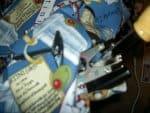In my last post, I said that one of the things I was thinking about was quilt teachers and/or teaching quiltmaking.
I think it is important, when teaching a class to do the following:
1. Know your subject : study the subject before you go to teach. Are there articles or books you can include in a bibliography? Have other people taught this subject? Can you review their work and incorporate salient points?
2. Be well prepared : people are busy and they are giving up their valuable time and money to take your class. Make you give them the courtesy of having everything (handouts, lecture, slides) organized and ready to go.
3. State your goals at the beginning of the class : Students will be much happier if they know what points you cover, what you plan to accomplish and how the timing will be in the class (when is lunch, when can they run to the restroom without missing a critical point).
4. Have handouts (with pictures, if appropriate) : people learn in different ways, so having a handout that describes (even with only bullet points) what you are saying will help students who learn by reading. It will also help jog the memories of those who learn by hearing or by being shown. Students will also be able to take notes on their handouts.
5. Don’t assume that since you can quilt you can also teach : teaching is a difficult profession and just because you make fabulous quilts doesn’t mean that you can teach others how to make fabulous quilts. Take classes where the teachers are GREAT and watch how they teach. Mary Mashuta and Ruth McDowell are both great teachers. Read up on how people learn. Teach a class or two for free to practice.
6. Manage students : if someone is hogging all of your time or all of the discussion time, cut them off and call on someone else. Don’t let students interrupt others. Students get frustrated if you let the class get out of control. Also, no teacher’s pets! If you like someone’s work, talk to them after class or contact them after you get home.
7. Don’t assume that people are there to hear your opinion : just because people are taking your class doesn’t meant they ONLY want to hear your opinion. Spread the wealth and give all sides of the story. This will also allow you highlight why your ideas/methods are better.
8. Acknowledge that people cannot absorb information for 8 hours: give students breaks (1 in the morning, 1 in the afternoon, lunch), but also give students time to work on their own after you teach them something new. Ideally, teach one or two new things, then let students do a short exercise to cement the information into your students’ brains.
9. Be professional : dress up if you need to feel professional to like a professional, but don’t become “one of the guys”. You are the teacher not a student, you are in charge, so act like it.
10. Make sure your handouts are well organized or track your lecture : nothing is more frustrating than a teacher whose lecture I cannot follow, but if the handouts are well organized, it makes it better. Try to synch your handouts and your lecture. Don’t write your handouts the night before. Start months in advance and keep revising and updating. Think of your lecture and the associated notes as a work in progress.
11. Consider whether you need a helper : this could be someone who passes papers out, gets your slides in the carousel, etc.
12. Walk around : look at what your students are doing. Look at their supplies. Make comments on everyone’s work. Some people won’t ask questions and you won’t know they are struggling unless you look at their work and their face.
People rate teachers and tell each other what they thought of teacher. Make sure you are thought well of by using the tips above.
